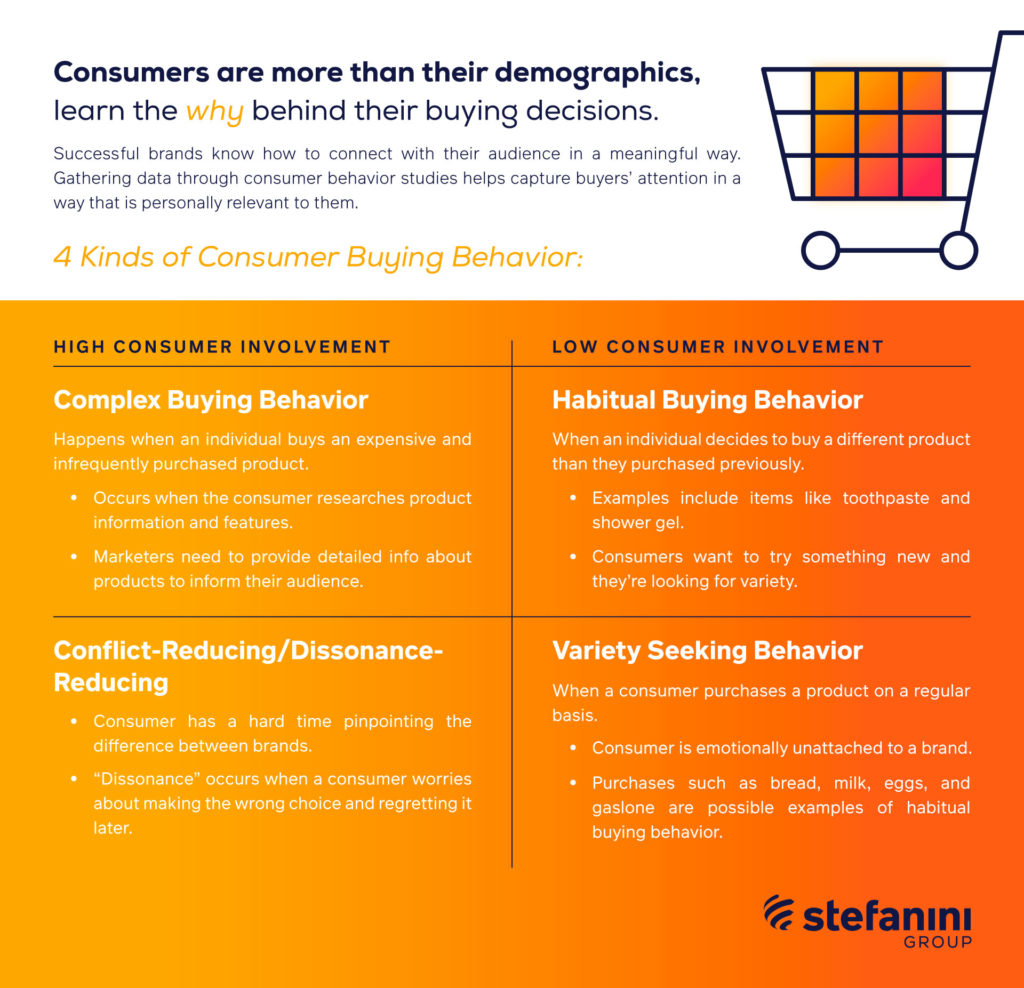Marketers study consumer behavior to get a better idea of what their customers want and how to attract new ones. Get more insights in our Trends blog!
A customer stands in the cereal aisle at the grocery store, overwhelmed with options: this cereal is made of whole grains, while that cereal contains an unhealthy serving of sugar. The customer stands there for at least ten minutes, looking through dozens of options. At some point, they are going to have to make a selection. When they do finally pick up an item and put it in their cart, are you able to pinpoint why they chose the product they chose?
This very question is the basis for an entire field of research within the marketing world: consumer (or customer) behavior.
New to the world of digital marketing? Get a peek at our guide here!
What is Consumer Behavior Analysis?
Consumers make choices like the above every day. Consumer behavior analysis arose from studying how people make purchase decisions with regard to a product, service or organization. According to the London School of Business and Finance, studying consumer behavior can allow you to answer several questions, such as:
- How consumers choose between the alternatives;
- How consumers feel about alternatives to their preferred brands;
- How consumer behavior is swayed by the consumer’s surrounding environment;
- How consumers behave while shopping;
- And how marketing campaigns can be improved to more effectively influence customer behavior.
Benefits of Studying Consumer Behavior
Consumer behavior should be taken into account regarding making decisions related to public relations and marketing. Studying it provides you with vital information regarding the thought process of consumers. It can also help you understand several factors:
- Attitudes: Consumer attitudes often affect their beliefs regarding certain products. Using consumer behavior models helps marketers create their campaigns to appeal to consumers, resulting in a greater market reach.
- Cultures: Constantly evolving cultures impact the designing of marketing campaigns. Studying consumer psychology can help you understand cultural nuances, thereby helping you determine the target market for your product.
- Perceptions: Studying consumer perceptions about your brand might help you uncover negative opinions, which you can then work on to improve your offering.
- Lifestyle: Comprehending consumer lifestyles can allow you to tweak your products to meet their specific requirements.
It starts with data. Get an overview of recent digital marketing statistics!

Types of Consumer Behavior
According to Management Education, there are four types of consumer buying behavior on the basis of buyer involvement while purchasing any product. They are as follows:
1. Complex Buying Behavior
This type of behavior occurs when the consumer is highly involved in the buying process and when there are significant differences between the brands they are studying. In this case, the consumer must collect proper information about product features; the marketer then must provide detailed information regarding the product’s attributes.
2. Conflict-Reducing/Dissonance-Reducing Buying Behavior
In this case, the consumer is highly involved in the purchasing process, but there are few differences between brands.
3. Habitual Buying Behavior
Here, there is low involvement on the consumer’s part and there are few differences between brands. The consumer buys the desired product quickly.
4. Variety Seeking Behavior
With this type of behavior, consumer involvement is low while buying the product, but there are significant differences between brands. Consumers generally buy different products not due to dissatisfaction from the earlier product, but because they seek variety. It becomes the duty of the marketer to encourage the consumer to buy their product by offering them discounts, free samples, and by advertising the product on the appropriate channels.
How to Do Customer Analysis and Analyze Customer Data
When creating a marketing strategy backed by data, you first need to understand factors influencing consumer behavior. According to Inc.com, while these factors may vary depending on the industry and the goals of your business, there are metrics that every company wants to know – what behavioral metrics influence your main business components? For many companies, there are three business drivers that affect them the most. For e-commerce businesses, customer loyalty plays a key role. Meanwhile, SaaS companies focus on their active users. Finally, for all types of companies, revenue is the main factor considered.
When it comes to analyzing your customers, there are four phases to consider:
1. Data Discovery – plan and gather information; then perform a data audit and present the results.
2. Exploratory Analysis – perform analyses that will provide an immediate look into your customers by identifying trends and segments. The following types of customer data analysis projects and reporting are beneficial during the exploratory phase:
- Decile Analysis: gives a preliminary insight into your customer base so you can begin to identify trends among your highly profitable customers.
- Loyalty Tracker: five common loyalty indicators include the dollar amount of purchases, time gap between visits, visit consistency, re-purchase rate, and the duration of the customer relationship.
- Migration/Change Analysis: examine how customers’ behavior changes over time using a migration analysis.
- Cohort Analysis: used to look at distinct groups of customers and how they perform versus other groups of customers.
- Basic Segmentation: the process of identifying customer segments and monitoring their behavior over time.
- Campaign/Contact Management Analysis: analyze past marketing campaigns and how they have impacted customer behavior.
3. Action – leverage additional models to enhance performance management, explanation of the data, and evaluating the impact. Once you have basic segmentations in place and understand how different customer segments perform, you can create measurable goals. Three additional analyses that you can perform during this stage to help facilitate an actionable approach include:
- Next–Best-Sell Model: gain insight into the types of products that existing customers are most likely to acquire in the future.
- Market Basket Analysis: decode and organize patterns of customer purchase behavior.
- Reactivation Model: find lapsed, or inactive, customers who can be converted back into active customers.
4. Prediction – creation of models that will help explain what will happen based on previous performance; then, use that information to make things happen/improv
- Attrition Model: pinpoint those customers who are most likely to discontinue transacting any business with your company
- Best Customer “Look–Alike” Modeling: identify existing customers with the characteristics of your best customers, but who have not exhibited transactional behaviors that qualify them to be classified as a best customer
- Customer Acquisition: identify the most attractive new customer prospects from a larger universe of prospect names.
Digital Marketing with Stefanini
We are focused on strategy, data science, media, and advertising, using data intelligence to boost business, connect people, and create experiences. Using our expertise, best practices, and statistical techniques, we provide actionable business insights based on data mining and predictive models. We provide these insights through research, analytics, and social insights.
Ready to get to know and better serve your customers while attracting new ones? Contact us today!
Download our eBook to learn more about customer analysis and how it can be applied to your business.



















